(All information courtesy of the instrument teams.)
![]() Previous IAU Circulars
Previous IAU Circulars
TITLE: GCN/SWIFT NOTICE
NOTICE_DATE: Sat 28 Jul 18 17:29:15 UT
NOTICE_TYPE: Swift-BAT GRB Position
TRIGGER_NUM: 850471, Seg_Num: 0
GRB_RA: 253.569d {+16h 54m 17s} (J2000),
253.944d {+16h 55m 47s} (current),
252.562d {+16h 50m 15s} (1950)
GRB_DEC: -54.031d {-54d 01' 50"} (J2000),
-54.060d {-54d 03' 34"} (current),
-53.950d {-53d 56' 58"} (1950)
GRB_ERROR: 3.00 [arcmin radius, statistical only]
GRB_INTEN: 2308 [cnts] Image_Peak=184 [image_cnts]
TRIGGER_DUR: 0.512 [sec]
TRIGGER_INDEX: 70 E_range: 15-50 keV
BKG_INTEN: 23003 [cnts]
BKG_TIME: 62930.66 SOD {17:28:50.66} UT
BKG_DUR: 8 [sec]
GRB_DATE: 18327 TJD; 209 DOY; 18/07/28
GRB_TIME: 62940.71 SOD {17:29:00.71} UT
GRB_PHI: 15.40 [deg]
GRB_THETA: 35.84 [deg]
SOLN_STATUS: 0x20000003
RATE_SIGNIF: 19.64 [sigma]
IMAGE_SIGNIF: 10.51 [sigma]
MERIT_PARAMS: +1 +0 +0 -1 +1 +0 +0 +1 +58 +0
SUN_POSTN: 127.96d {+08h 31m 51s} +18.87d {+18d 52' 10"}
SUN_DIST: 126.03 [deg] Sun_angle= -8.4 [hr] (East of Sun)
MOON_POSTN: 317.96d {+21h 11m 49s} -17.07d {-17d 04' 19"}
MOON_DIST: 61.08 [deg]
MOON_ILLUM: 99 [%]
GAL_COORDS: 333.97, -6.51 [deg] galactic lon,lat of the burst (or transient)
ECL_COORDS: 258.80,-31.23 [deg] ecliptic lon,lat of the burst (or transient)
COMMENTS: SWIFT-BAT GRB Coordinates.
COMMENTS: This is a rate trigger.
COMMENTS: A point_source was found.
COMMENTS: This does not match any source in the on-board catalog.
COMMENTS: This does not match any source in the ground catalog.
COMMENTS: This is a GRB.
COMMENTS: This trigger occurred at longitude,latitude = 236.54,-20.50 [deg].
COMMENTS:
COMMENTS: NOTE: This BAT event is temporally(2.0<100sec) coincident with the FERMI_GBM event (trignum=554491747).
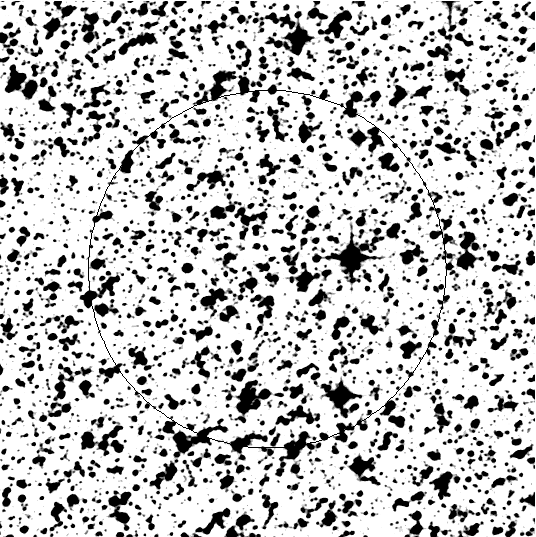
TITLE: GCN/FERMI NOTICE
NOTICE_DATE: Sat 28 Jul 18 17:29:26 UT
NOTICE_TYPE: Fermi-GBM Flight Position
RECORD_NUM: 44
TRIGGER_NUM: 554491747
GRB_RA: 240.917d {+16h 03m 40s} (J2000),
241.233d {+16h 04m 56s} (current),
240.067d {+16h 00m 16s} (1950)
GRB_DEC: -40.850d {-40d 51' 00"} (J2000),
-40.900d {-40d 54' 00"} (current),
-40.713d {-40d 42' 45"} (1950)
GRB_ERROR: 21.72 [deg radius, statistical plus systematic]
GRB_INTEN: 72 [cnts/sec]
DATA_SIGNIF: 6.20 [sigma]
INTEG_TIME: 2.048 [sec]
GRB_DATE: 18327 TJD; 209 DOY; 18/07/28
GRB_TIME: 62942.28 SOD {17:29:02.28} UT
GRB_PHI: 262.00 [deg]
GRB_THETA: 50.00 [deg]
DATA_TIME_SCALE: 2.0480 [sec]
HARD_RATIO: 6.45
LOC_ALGORITHM: 3 (version number of)
MOST_LIKELY: 38% SGR_1806n20
2nd_MOST_LIKELY: 30% GRB
DETECTORS: 0,0,0, 1,0,0, 0,1,0, 0,0,0, 0,0,
SUN_POSTN: 127.96d {+08h 31m 51s} +18.87d {+18d 52' 10"}
SUN_DIST: 119.63 [deg] Sun_angle= -7.6 [hr] (East of Sun)
MOON_POSTN: 317.96d {+21h 11m 50s} -17.07d {-17d 04' 17"}
MOON_DIST: 69.01 [deg]
MOON_ILLUM: 99 [%]
GAL_COORDS: 337.63, 8.73 [deg] galactic lon,lat of the burst (or transient)
ECL_COORDS: 247.01,-19.70 [deg] ecliptic lon,lat of the burst (or transient)
LC_URL: http://heasarc.gsfc.nasa.gov/FTP/fermi/data/gbm/triggers/2018/bn180728728/quicklook/glg_lc_medres34_bn180728728.gif
COMMENTS: Fermi-GBM Flight-calculated Coordinates.
COMMENTS: This trigger occurred at longitude,latitude = 144.48,-21.90 [deg].
COMMENTS: The LC_URL file will not be created until ~15 min after the trigger.
COMMENTS:
COMMENTS: NOTE: This GBM event is temporally(2.0<100sec) coincident with the SWIFT_BAT event (trignum=850471).
TITLE: GCN/FERMI NOTICE
NOTICE_DATE: Sat 28 Jul 18 17:29:39 UT
NOTICE_TYPE: Fermi-GBM Flight Position
RECORD_NUM: 66
TRIGGER_NUM: 554491747
GRB_RA: 251.250d {+16h 45m 00s} (J2000),
251.599d {+16h 46m 24s} (current),
250.313d {+16h 41m 15s} (1950)
GRB_DEC: -48.500d {-48d 30' 00"} (J2000),
-48.533d {-48d 31' 58"} (current),
-48.408d {-48d 24' 29"} (1950)
GRB_ERROR: 3.60 [deg radius, statistical plus systematic]
GRB_INTEN: 2903 [cnts/sec]
DATA_SIGNIF: 66.20 [sigma]
INTEG_TIME: 0.256 [sec]
GRB_DATE: 18327 TJD; 209 DOY; 18/07/28
GRB_TIME: 62942.28 SOD {17:29:02.28} UT
GRB_PHI: 258.00 [deg]
GRB_THETA: 40.00 [deg]
DATA_TIME_SCALE: 0.2560 [sec]
HARD_RATIO: 2.85
LOC_ALGORITHM: 3 (version number of)
MOST_LIKELY: 61% GRB
2nd_MOST_LIKELY: 25% Generic SGR
DETECTORS: 0,0,0, 1,0,0, 0,1,0, 0,0,0, 0,0,
SUN_POSTN: 127.96d {+08h 31m 51s} +18.87d {+18d 52' 10"}
SUN_DIST: 126.12 [deg] Sun_angle= -8.2 [hr] (East of Sun)
MOON_POSTN: 317.96d {+21h 11m 50s} -17.07d {-17d 04' 16"}
MOON_DIST: 61.72 [deg]
MOON_ILLUM: 99 [%]
GAL_COORDS: 337.31, -1.86 [deg] galactic lon,lat of the burst (or transient)
ECL_COORDS: 256.30,-25.95 [deg] ecliptic lon,lat of the burst (or transient)
LC_URL: http://heasarc.gsfc.nasa.gov/FTP/fermi/data/gbm/triggers/2018/bn180728728/quicklook/glg_lc_medres34_bn180728728.gif
COMMENTS: Fermi-GBM Flight-calculated Coordinates.
COMMENTS: This trigger occurred at longitude,latitude = 144.48,-21.90 [deg].
COMMENTS: The LC_URL file will not be created until ~15 min after the trigger.
COMMENTS:
COMMENTS: NOTE: This GBM event is temporally(2.0<100sec) coincident with the SWIFT_BAT event (trignum=850471).
TITLE: GCN/FERMI NOTICE
NOTICE_DATE: Sat 28 Jul 18 17:29:45 UT
NOTICE_TYPE: Fermi-GBM Flight Position
RECORD_NUM: 70
TRIGGER_NUM: 554491747
GRB_RA: 251.200d {+16h 44m 48s} (J2000),
251.549d {+16h 46m 12s} (current),
250.262d {+16h 41m 03s} (1950)
GRB_DEC: -48.583d {-48d 34' 59"} (J2000),
-48.616d {-48d 36' 58"} (current),
-48.491d {-48d 29' 28"} (1950)
GRB_ERROR: 3.43 [deg radius, statistical plus systematic]
GRB_INTEN: 5261 [cnts/sec]
DATA_SIGNIF: 365.20 [sigma]
INTEG_TIME: 2.048 [sec]
GRB_DATE: 18327 TJD; 209 DOY; 18/07/28
GRB_TIME: 62942.28 SOD {17:29:02.28} UT
GRB_PHI: 258.00 [deg]
GRB_THETA: 40.00 [deg]
DATA_TIME_SCALE: 2.0480 [sec]
HARD_RATIO: 2.20
LOC_ALGORITHM: 3 (version number of)
MOST_LIKELY: 67% GRB
2nd_MOST_LIKELY: 20% Generic SGR
DETECTORS: 0,0,0, 1,0,0, 0,1,0, 0,0,0, 0,0,
SUN_POSTN: 127.96d {+08h 31m 51s} +18.87d {+18d 52' 10"}
SUN_DIST: 126.07 [deg] Sun_angle= -8.2 [hr] (East of Sun)
MOON_POSTN: 317.96d {+21h 11m 50s} -17.07d {-17d 04' 15"}
MOON_DIST: 61.76 [deg]
MOON_ILLUM: 99 [%]
GAL_COORDS: 337.22, -1.89 [deg] galactic lon,lat of the burst (or transient)
ECL_COORDS: 256.27,-26.04 [deg] ecliptic lon,lat of the burst (or transient)
LC_URL: http://heasarc.gsfc.nasa.gov/FTP/fermi/data/gbm/triggers/2018/bn180728728/quicklook/glg_lc_medres34_bn180728728.gif
COMMENTS: Fermi-GBM Flight-calculated Coordinates.
COMMENTS: This trigger occurred at longitude,latitude = 144.48,-21.90 [deg].
COMMENTS: The LC_URL file will not be created until ~15 min after the trigger.
COMMENTS:
COMMENTS: NOTE: This GBM event is temporally(2.0<100sec) coincident with the SWIFT_BAT event (trignum=850471).
TITLE: GCN/INTEGRAL NOTICE
NOTICE_DATE: Sat 28 Jul 18 17:30:05 UT
NOTICE_TYPE: INTEGRAL SPI ACS Trigger
TRIGGER_NUM: 8111, Sub_Num: 0
GRB_INTEN: 9.40 [sigma]
GRB_TIME: 62951.03 SOD {17:29:11.03} UT
GRB_DATE: 18327 TJD; 209 DOY; 18/07/28
COMMENTS: INTEGRAL SPI_ACS GRB Trigger.
COMMENTS: Time_Scale=2.0000 and Time_Error=1.0000.
COMMENTS:
COMMENTS: NOTE: This SPIACS event is temporally(9.0<100sec) coincident with the FERMI_GBM event (trignum=554491747).
COMMENTS:
COMMENTS: The SPIACS lightcurve can be found at:
COMMENTS: ftp://isdcarc.unige.ch/arc/FTP/ibas/spiacs/2018-07/2018-07-28T17-29-10.8592-08810-60304-0.lc
TITLE: GCN/SWIFT NOTICE
NOTICE_DATE: Sat 28 Jul 18 17:33:13 UT
NOTICE_TYPE: Swift-BAT GRB Lightcurve
TRIGGER_NUM: 850471, Seg_Num: 0
GRB_RA: 253.569d {+16h 54m 17s} (J2000),
253.944d {+16h 55m 47s} (current),
252.562d {+16h 50m 15s} (1950)
GRB_DEC: -54.031d {-54d 01' 50"} (J2000),
-54.060d {-54d 03' 34"} (current),
-53.950d {-53d 56' 58"} (1950)
GRB_DATE: 18327 TJD; 209 DOY; 18/07/28
GRB_TIME: 62940.71 SOD {17:29:00.71} UT
TRIGGER_INDEX: 70
GRB_PHI: 15.40 [deg]
GRB_THETA: 35.84 [deg]
DELTA_TIME: -44.00 [sec]
TRIGGER_DUR: 0.512 [sec]
SOLN_STATUS: 0x3
RATE_SIGNIF: 19.64 [sigma]
IMAGE_SIGNIF: 10.51 [sigma]
LC_URL: sw00850471000msb.lc
SUN_POSTN: 127.96d {+08h 31m 51s} +18.87d {+18d 52' 08"}
SUN_DIST: 126.03 [deg] Sun_angle= -8.4 [hr] (East of Sun)
MOON_POSTN: 317.99d {+21h 11m 57s} -17.07d {-17d 03' 54"}
MOON_DIST: 61.11 [deg]
MOON_ILLUM: 99 [%]
GAL_COORDS: 333.97, -6.51 [deg] galactic lon,lat of the burst (or transient)
ECL_COORDS: 258.80,-31.23 [deg] ecliptic lon,lat of the burst (or transient)
COMMENTS: SWIFT-BAT GRB Lightcurve.
COMMENTS:
COMMENTS: The next comments were copied from the BAT_POS Notice:
COMMENTS: This is a rate trigger.
COMMENTS: A point_source was found.
COMMENTS: This does not match any source in the on-board catalog.
COMMENTS: This does not match any source in the ground catalog.
COMMENTS: This is a GRB.
COMMENTS: This trigger occurred at longitude,latitude = 236.54,-20.50 [deg].
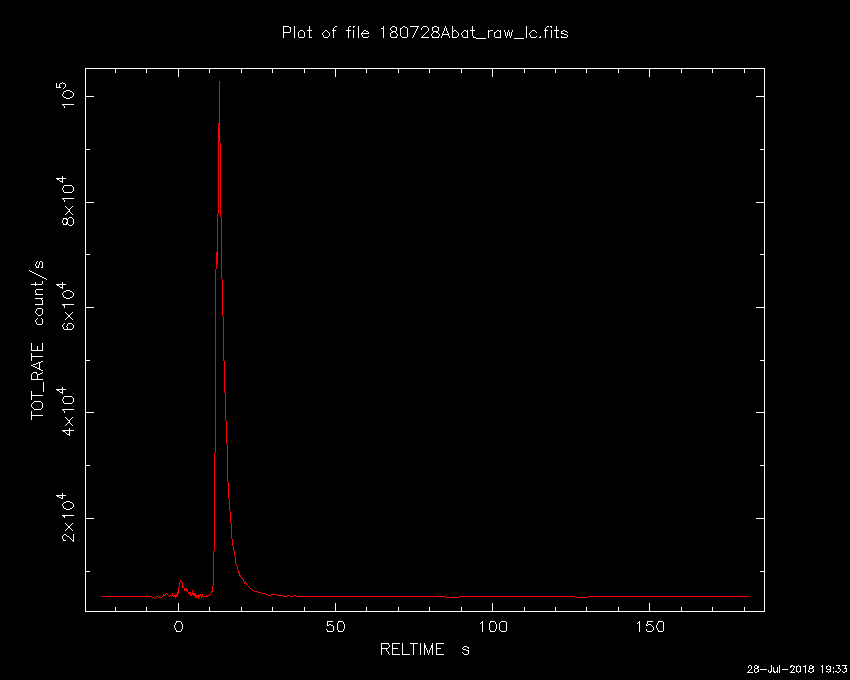
RA(J2000) = 16h 54m 17s Dec(J2000) = -54d 01' 50"with an uncertainty of 3 arcmin (radius, 90% containment, including systematic uncertainty). The BAT light curve showed a small precursor followed 10 seconds later by a bright FRED pulse of ~20 s duration. The peak count rate was ~100,000 counts/sec (15-350 keV), at ~13 sec after the trigger.
TITLE: GCN/SWIFT NOTICE
NOTICE_DATE: Sat 28 Jul 18 17:58:31 UT
NOTICE_TYPE: Swift-XRT Image
TRIGGER_NUM: 850471, Seg_Num: 0
GRB_RA: 253.5648d {+16h 54m 15.5s} (J2000),
253.9397d {+16h 55m 45.5s} (current),
252.5577d {+16h 50m 13.8s} (1950)
GRB_DEC: -54.0437d {-54d 02' 37.3"} (J2000),
-54.0726d {-54d 04' 21.4"} (current),
-53.9626d {-53d 57' 45.3"} (1950)
GRB_ERROR: 5.8 [arcsec, radius, statistical plus systematic]
GRB_INTEN: 37 [cnts]
IMG_START_DATE: 18327 TJD; 209 DOY; 18/07/28
IMG_START_TIME: 64671.51 SOD {17:57:51.51} UT, 1730.8 [sec] since BAT Trigger Time
CENTROID_X: 332.06, raw= 332 [pixels]
CENTROID_Y: 387.86, raw= 388 [pixels]
ROLL: 251.66 [deg]
GAIN: 1
MODE: 3, Long Image mode
WAVEFORM: 134
EXPO_TIME: 2.50 [sec]
GRB_POS_XRT_Y: 210.89
GRB_POS_XRT_Z: 60.50
IMAGE_URL: sw00850471000msxps_rw.img
SUN_POSTN: 127.98d {+08h 31m 55s} +18.86d {+18d 51' 53"}
SUN_DIST: 126.01 [deg] Sun_angle= -8.4 [hr] (East of Sun)
MOON_POSTN: 318.20d {+21h 12m 49s} -17.02d {-17d 01' 17"}
MOON_DIST: 61.27 [deg]
MOON_ILLUM: 99 [%]
GAL_COORDS: 333.96, -6.51 [deg] galactic lon,lat of the burst
ECL_COORDS: 258.80,-31.24 [deg] ecliptic lon,lat of the burst
COMMENTS: SWIFT-XRT Image.

TITLE: GCN/SWIFT NOTICE
NOTICE_DATE: Sat 28 Jul 18 17:58:39 UT
NOTICE_TYPE: Swift-XRT Processed Image
TRIGGER_NUM: 850471, Seg_Num: 0
GRB_RA: 253.5648d {+16h 54m 15.5s} (J2000),
253.9397d {+16h 55m 45.5s} (current),
252.5577d {+16h 50m 13.8s} (1950)
GRB_DEC: -54.0437d {-54d 02' 37.3"} (J2000),
-54.0726d {-54d 04' 21.4"} (current),
-53.9626d {-53d 57' 45.3"} (1950)
GRB_ERROR: 5.8 [arcsec, radius, statistical plus systematic]
GRB_INTEN: 37 [cnts]
IMG_START_DATE: 18327 TJD; 209 DOY; 18/07/28
IMG_START_TIME: 64671.51 SOD {17:57:51.51} UT, 1730.8 [sec] since BAT Trigger Time
CENTROID_X: 332.06, raw= 332 [pixels]
CENTROID_Y: 387.86, raw= 388 [pixels]
ROLL: 251.66 [deg]
GAIN: 1
MODE: 3, Long Image mode
WAVEFORM: 134
EXPO_TIME: 2.50 [sec]
GRB_POS_XRT_Y: 210.89
GRB_POS_XRT_Z: 60.50
IMAGE_URL: sw00850471000msxps_rw.img
SUN_POSTN: 127.98d {+08h 31m 55s} +18.86d {+18d 51' 53"}
SUN_DIST: 126.01 [deg] Sun_angle= -8.4 [hr] (East of Sun)
MOON_POSTN: 318.20d {+21h 12m 49s} -17.02d {-17d 01' 17"}
MOON_DIST: 61.27 [deg]
MOON_ILLUM: 99 [%]
GAL_COORDS: 333.96, -6.51 [deg] galactic lon,lat of the burst
ECL_COORDS: 258.80,-31.24 [deg] ecliptic lon,lat of the burst
COMMENTS: SWIFT-XRT Processed Image.

TITLE: GCN/SWIFT NOTICE
NOTICE_DATE: Sat 28 Jul 18 17:58:21 UT
NOTICE_TYPE: Swift-XRT Position
TRIGGER_NUM: 850471, Seg_Num: 0
GRB_RA: 253.5648d {+16h 54m 15.55s} (J2000),
253.9397d {+16h 55m 45.52s} (current),
252.5577d {+16h 50m 13.84s} (1950)
GRB_DEC: -54.0437d {-54d 02' 37.3"} (J2000),
-54.0726d {-54d 04' 21.4"} (current),
-53.9626d {-53d 57' 45.3"} (1950)
GRB_ERROR: 5.8 [arcsec radius, statistical plus systematic, 90% containment]
GRB_INTEN: 7.92e-10 [erg/cm2/sec]
GRB_SIGNIF: 6.08 [sigma]
IMG_START_DATE: 18327 TJD; 209 DOY; 18/07/28
IMG_START_TIME: 64671.51 SOD {17:57:51.51} UT, 1730.8 [sec] since BAT Trigger Time
TAM[0-3]: 327.63 237.15 261.64 243.55
AMPLIFIER: 2
WAVEFORM: 134
SUN_POSTN: 127.98d {+08h 31m 55s} +18.86d {+18d 51' 53"}
SUN_DIST: 126.01 [deg] Sun_angle= -8.4 [hr] (East of Sun)
MOON_POSTN: 318.20d {+21h 12m 48s} -17.02d {-17d 01' 19"}
MOON_DIST: 61.27 [deg]
MOON_ILLUM: 99 [%]
GAL_COORDS: 333.96, -6.51 [deg] galactic lon,lat of the burst
ECL_COORDS: 258.80,-31.24 [deg] ecliptic lon,lat of the burst
COMMENTS: SWIFT-XRT Coordinates.
COMMENTS: The XRT position is 0.79 arcmin from the BAT position.
TITLE: GCN/SWIFT NOTICE
NOTICE_DATE: Sat 28 Jul 18 18:03:23 UT
NOTICE_TYPE: Swift-UVOT Source List
TRIGGER_NUM: 850471, Seg_Num: 0
POINT_RA: 253.506d {+16h 54m 01s} (J2000)
POINT_DEC: -53.994d {-53d 59' 37"} (J2000)
POINT_ROLL: 251.660d
IMG_START_DATE: 18327 TJD; 209 DOY; 18/07/28
IMG_START_TIME: 64681.12 SOD {17:58:01.12} UT, 1740.4 [sec] since BAT Trigger Time
FILTER: 10, White
BKG_MEAN: 6.827
N_STARS: 190
X_OFFSET: 164 [pixels]
Y_OFFSET: 320 [pixels]
X_MAX: 1123 [pixels]
Y_MAX: 1279 [pixels]
DET_THRESH: 22
PHOTO_THRESH: 14
SL_URL: sw00850471000msufc1740.fits
SUN_POSTN: 127.98d {+08h 31m 56s} +18.86d {+18d 51' 50"}
SUN_DIST: 125.99 [deg] Sun_angle= -8.4 [hr] (East of Sun)
MOON_POSTN: 318.24d {+21h 12m 59s} -17.01d {-17d 00' 47"}
MOON_DIST: 61.33 [deg]
MOON_ILLUM: 99 [%]
GAL_COORDS: 333.97, -6.45 [deg] galactic lon,lat of the pointing direction
ECL_COORDS: 258.75,-31.20 [deg] ecliptic lon,lat of the pointing direction
COMMENTS: SWIFT-UVOT Source List.
TITLE: GCN/SWIFT NOTICE
NOTICE_DATE: Sat 28 Jul 18 18:03:44 UT
NOTICE_TYPE: Swift-UVOT Processed Source List
TRIGGER_NUM: 850471, Seg_Num: 0
POINT_RA: 253.506d {+16h 54m 01s} (J2000)
POINT_DEC: -53.994d {-53d 59' 37"} (J2000)
POINT_ROLL: 251.660d
IMG_START_DATE: 18327 TJD; 209 DOY; 18/07/28
IMG_START_TIME: 64681.12 SOD {17:58:01.12} UT, 1740.4 [sec] since BAT Trigger Time
FILTER: 10, White
BKG_MEAN: 6.827
N_STARS: 190
X_OFFSET: 164 [pixels]
Y_OFFSET: 320 [pixels]
X_MAX: 1123 [pixels]
Y_MAX: 1279 [pixels]
DET_THRESH: 22
PHOTO_THRESH: 14
SL_URL: sw00850471000msufc1740.fits
SUN_POSTN: 127.98d {+08h 31m 56s} +18.86d {+18d 51' 50"}
SUN_DIST: 125.99 [deg] Sun_angle= -8.4 [hr] (East of Sun)
MOON_POSTN: 318.25d {+21h 12m 59s} -17.01d {-17d 00' 45"}
MOON_DIST: 61.33 [deg]
MOON_ILLUM: 99 [%]
GAL_COORDS: 333.97, -6.45 [deg] galactic lon,lat of the pointing direction
ECL_COORDS: 258.75,-31.20 [deg] ecliptic lon,lat of the pointing direction
COMMENTS: SWIFT-UVOT Processed Source List.
COMMENTS: All 4 attachments are included.
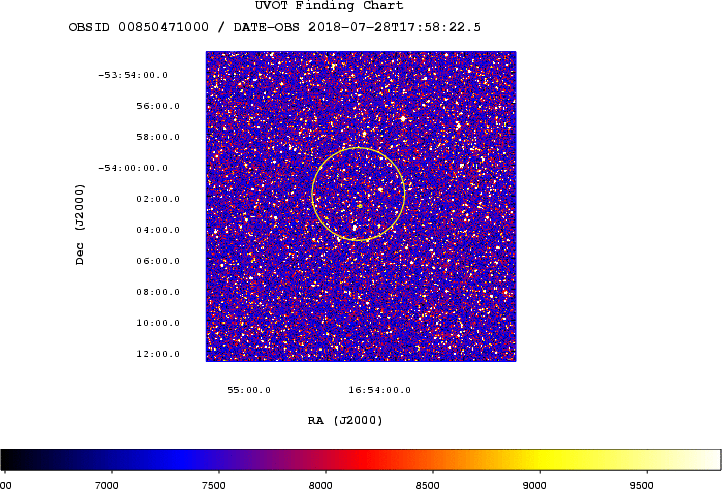
TITLE: GCN/SWIFT NOTICE
NOTICE_DATE: Sat 28 Jul 18 18:05:57 UT
NOTICE_TYPE: Swift-UVOT Image
TRIGGER_NUM: 850471, Seg_Num: 0
POINT_RA: 253.506d {+16h 54m 01s} (J2000)
POINT_DEC: -53.994d {-53d 59' 37"} (J2000)
ROLL: 251.660d
IMG_START_DATE: 18327 TJD; 209 DOY; 18/07/28
IMG_START_TIME: 64681.12 SOD {17:58:01.12} UT, 1740.4 [sec] since BAT Trigger Time
FILTER: 10, White
EXPOSURE_ID: 554493502
X_OFFSET: 484 [pixels]
Y_OFFSET: 546 [pixels]
WIDTH: 160 [pixels]
HEIGHT: 160 [pixels]
X_GRB_POS: 644
Y_GRB_POS: 706
BINNING_INDEX: 1
IM_URL: sw00850471000msuni1762.fits
SUN_POSTN: 127.99d {+08h 31m 57s} +18.86d {+18d 51' 49"}
SUN_DIST: 125.98 [deg] Sun_angle= -8.4 [hr] (East of Sun)
MOON_POSTN: 318.27d {+21h 13m 04s} -17.01d {-17d 00' 31"}
MOON_DIST: 61.34 [deg]
MOON_ILLUM: 99 [%]
GAL_COORDS: 333.97, -6.45 [deg] galactic lon,lat of the pointing direction
ECL_COORDS: 258.75,-31.20 [deg] ecliptic lon,lat of the pointing direction
COMMENTS: SWIFT-UVOT Image.
COMMENTS: The GRB Position came from the XRT Position Command.
COMMENTS: The image has 2x2 binning (compression).
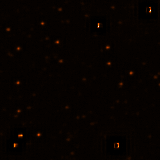
TITLE: GCN/SWIFT NOTICE
NOTICE_DATE: Sat 28 Jul 18 18:06:07 UT
NOTICE_TYPE: Swift-UVOT Processed Image
TRIGGER_NUM: 850471, Seg_Num: 0
POINT_RA: 253.506d {+16h 54m 01s} (J2000)
POINT_DEC: -53.994d {-53d 59' 37"} (J2000)
ROLL: 251.660d
IMG_START_DATE: 18327 TJD; 209 DOY; 18/07/28
IMG_START_TIME: 64681.12 SOD {17:58:01.12} UT, 1740.4 [sec] since BAT Trigger Time
FILTER: 10, White
EXPOSURE_ID: 554493502
X_OFFSET: 484 [pixels]
Y_OFFSET: 546 [pixels]
WIDTH: 160 [pixels]
HEIGHT: 160 [pixels]
X_GRB_POS: 644
Y_GRB_POS: 706
BINNING_INDEX: 1
IM_URL: sw00850471000msuni1762.fits
SUN_POSTN: 127.99d {+08h 31m 57s} +18.86d {+18d 51' 49"}
SUN_DIST: 125.98 [deg] Sun_angle= -8.4 [hr] (East of Sun)
MOON_POSTN: 318.27d {+21h 13m 04s} -17.01d {-17d 00' 30"}
MOON_DIST: 61.34 [deg]
MOON_ILLUM: 99 [%]
GAL_COORDS: 333.97, -6.45 [deg] galactic lon,lat of the pointing direction
ECL_COORDS: 258.75,-31.20 [deg] ecliptic lon,lat of the pointing direction
COMMENTS: SWIFT-UVOT Processed Image.
COMMENTS: The GRB Position came from the XRT Position Command.
COMMENTS: The image has 2x2 binning (compression).
COMMENTS: All 4 attachments are included.
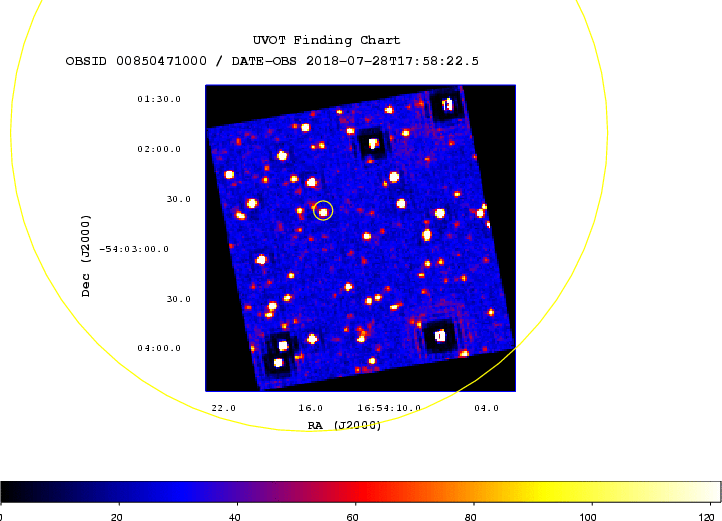
RA(J2000) = +16h 54m 15.55s Dec(J2000) = -54d 02' 37.3"with an uncertainty of 5.8 arcseconds (radius, 90% containment). This location is 46 arcseconds from the BAT onboard position, within the BAT error circle. No event data are yet available to determine the column density using X-ray spectroscopy.
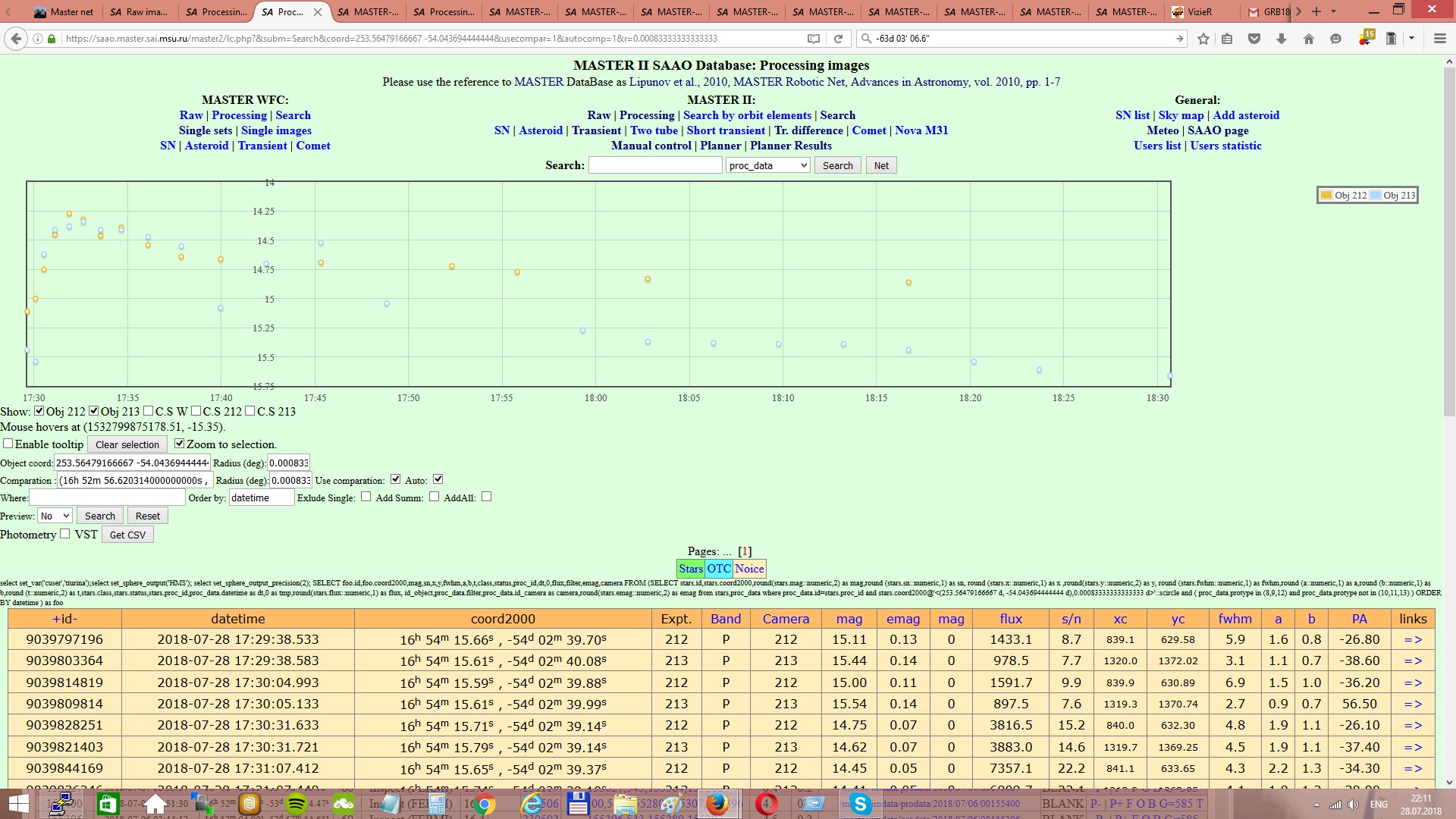
RA (J2000): 16h 54m 15.63s Dec (J2000): -54d 02' 40.3"with an uncertainty of 1.5 arcsec (radius, 90% confidence).
Total column: 3.8 (+/-0.5) x 10^21 cm^-2 Galactic foreground: 3.2 x 10^21 cm^-2 Excess significance: 2.2 sigma Photon index: 1.75 (+/-0.09)If the light curve continues to decay with a power-law decay index of 0.58, the count rate at T+24 hours will be 0.65 count s^-1, corresponding to an observed (unabsorbed) 0.3-10 keV flux of 3.0 x 10^-11 (4.0 x 10^-11) erg cm^-2 s^-1.
RA(J2000) = 16h 54m 17.7s
Dec(J2000) = -54d 02' 13.7"
with an uncertainty of 1.0 arcmin, (radius, sys+stat, 90% containment).
The partial coding was 57%.
RA (J2000) = 16:54:15.53 = 253.56472 (deg.)
Dec (J2000) = -54:02:40.2 = -54.04451 (deg.)
with an estimated uncertainty of 0.43 arc sec. (radius, 90% confidence),
consistent with MASTER OT J165415.75-540239.27 (Lipunov et al., GCN #23050).
Filter T_start(s) T_stop(s) Exp(s) Mag white 1740 1890 147 16.25 +/- 0.03 white 7713 15148 465 17.28 +/- 0.03 v 1897 1917 20 16.07 +/- 0.14 b 1995 2013 18 16.58 +/- 0.10 u 1970 1990 20 15.93 +/- 0.10 w1 1946 1966 20 16.20 +/- 0.17 m2 1921 2114 39 16.60 +/- 0.18 w2 2045 2065 19 16.37 +/- 0.19The magnitudes in the table are not corrected for the Galactic extinction due to the reddening of E(B-V) = 0.29 in the direction of the burst (Schlegel et al. 1998).
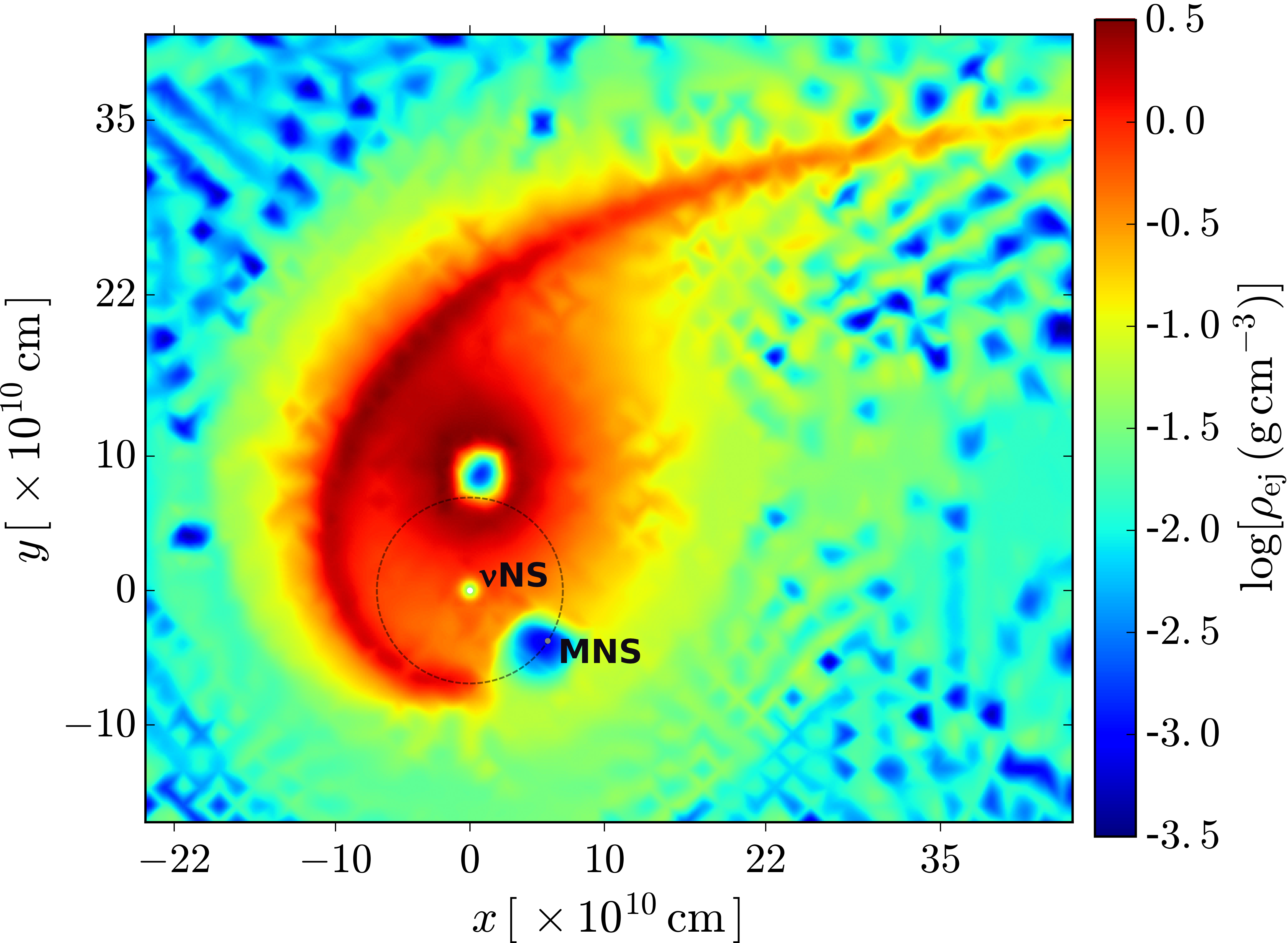
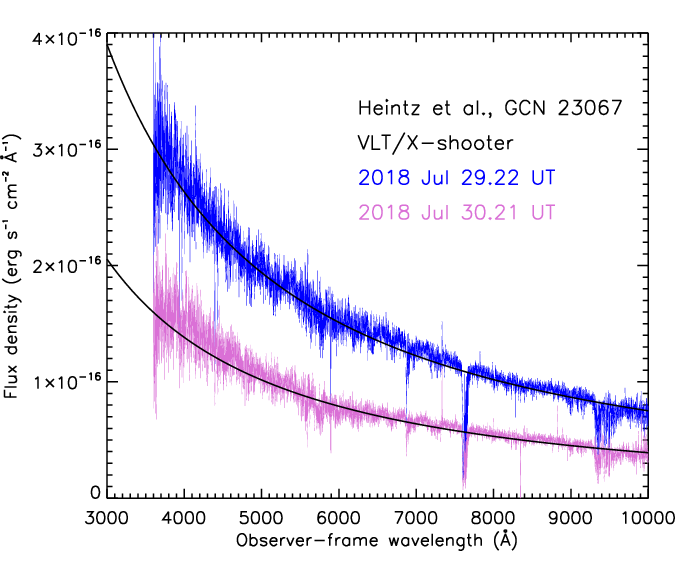
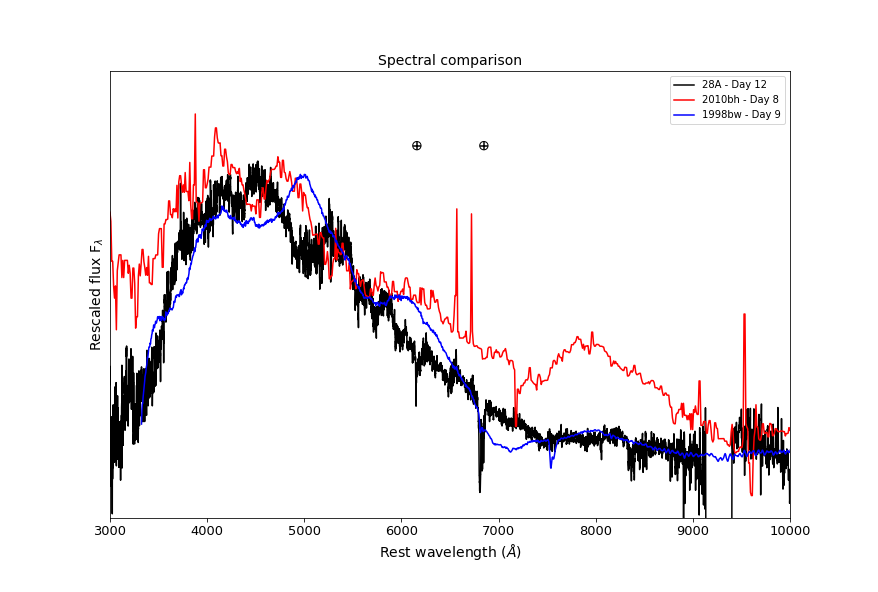
Date_Time,UT | Exp,s | MASTER-Site | m_lim| M 2018-07-29 21:18:37.092 | 2340 | MASTER-SAAO | 21.8 | -16.3 2018-07-30 21:07:24.839 | 1440 | MASTER-SAAO | 20.8 | -17.3 2018-07-30 21:07:24.912 | 1440 | MASTER-SAAO | 21.4 | -16.7 2018-08-01 19:11:32.906 | 1620 | MASTER-SAAO | 20.9 | -17.2 2018-08-01 19:15:07.977 | 1620 | MASTER-SAAO | 20.9 | -17.2 2018-08-02 17:03:40.025 | 3780 | MASTER-SAAO | 20.8 | -17.2 2018-08-02 18:12:49.446 | 3960 | MASTER-SAAO | 20.9 | -17.2 2018-08-03 17:53:21.097 | 4140 | MASTER-SAAO | 20.8 | -17.3 2018-08-03 17:53:21.347 | 4140 | MASTER-SAAO | 21.1 | -17.0 2018-08-03 23:21:10.842 | 3420 | MASTER-OAFA | 20.6 | -17.5 2018-08-04 17:05:35.120 | 2700 | MASTER-SAAO | 20.9 | -17.2 2018-08-04 17:12:46.879 | 2880 | MASTER-SAAO | 20.8 | -17.3 2018-08-04 23:07:09.154 | 720 | MASTER-OAFA | 20.5 | -17.6 2018-08-05 22:18:29.225 | 3240 | MASTER-SAAO | 20.8 | -17.3 2018-08-05 22:22:04.704 | 3240 | MASTER-SAAO | 21.1 | -17.0 2018-08-05 23:08:46.934 | 1260 | MASTER-OAFA | 21.5 | -16.5 2018-08-06 18:46:19.565 | 3600 | MASTER-SAAO | 20.8 | -17.3 2018-08-06 18:46:19.605 | 3600 | MASTER-SAAO | 20.8 | -17.3 2018-08-07 00:26:41.653 | 900 | MASTER-OAFA | 20.4 | -17.7 2018-08-07 03:30:36.096 | 2520 | MASTER-OAFA | 20.6 | -17.5 2018-08-07 17:15:34.447 | 3780 | MASTER-SAAO | 20.9 | -17.2 2018-08-07 18:23:07.857 | 3780 | MASTER-SAAO | 21.7 | -16.4 2018-08-08 17:59:05.042 | 4140 | MASTER-SAAO | 20.8 | -17.3 2018-08-08 18:02:42.597 | 4140 | MASTER-SAAO | 20.9 | -17.2 2018-08-08 23:11:34.904 | 3240 | MASTER-OAFA | 21.9 | -16.2 2018-08-09 18:55:17.807 | 540 | MASTER-SAAO | 20.8 | -17.2 2018-08-09 18:58:54.517 | 540 | MASTER-SAAO | 20.8 | -17.2 2018-08-09 23:04:26.723 | 3240 | MASTER-OAFA | 20.5 | -17.5 2018-08-10 17:00:41.943 | 2520 | MASTER-SAAO | 20.9 | -17.1 2018-08-11 00:08:05.570 | 4500 | MASTER-OAFA | 20.7 | -17.3 2018-08-11 18:43:29.720 | 7020 | MASTER-SAAO | 20.9 | -17.1 2018-08-11 23:12:32.140 | 3240 | MASTER-OAFA | 20.6 | -17.4 2018-08-12 19:46:57.192 | 7560 | MASTER-SAAO | 22.1 | -15.9 2018-08-12 19:46:57.246 | 7560 | MASTER-SAAO | 20.9 | -17.1 2018-08-12 23:18:02.053 | 3240 | MASTER-OAFA | 19.8 | -18.2 2018-08-13 07:43:55.504 | 3420 | MASTER-OAFA | 21.2 | -16.8We have carried out preliminary photometry of MASTER early observations (Lipunov et al. GCN 23048; GCN23050;) also we report about considerable polarization of optical radiation of gamma burst the first minute after its beginning.